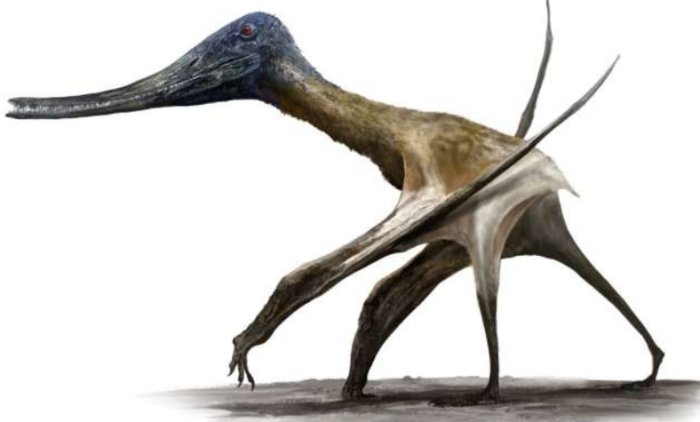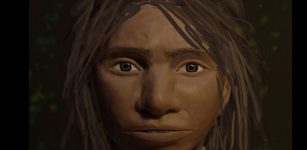When And How Pterosaurs Went From Tiny Tree-Climbers To Towering Terrestrial Titans
Eddie Gonzales Jr. – MessageToEagle.com – Paleontologists at the Centre for Palaeobiology and Biosphere Evolution at the University of Leicester have identified, for the first time, the evolutionary adaptations that enabled ancient pterosaurs to achieve enormous sizes. This discovery sheds light on how these prehistoric creatures evolved to become some of the largest flying animals in history.
Short-tailed pterosaurs, like this Balaenognathus were adapted for a life on the ground. This bizarre creature boasted nearly 500 needle-like teeth in its jaws, and likely used them to filter-feed on tiny food items from shallow waters, similar to the feeding habits of modern flamingos. Credit: Rudolf Hima
The discovery revealed a surprising twist – the ability to walk efficiently on the ground played a crucial role in determining how large the biggest flying animals could grow, with some reaching wingspans of up to 10 metres.
In a new study published today (4 October) in Current Biology, a team of researchers led by the University of Leicester examined the hands and feet of pterosaurs from around the world and across their entire evolutionary history.
They uncovered a surprising level of variation similar to that seen across living birds. This discovery indicates that pterosaurs were not confined to a life in the skies but were also adapted to a wide range of terrestrial lifestyles, from tree-climbing in early species to more ground-based lifestyles in later ones.
The evolution of pterosaurs, the first true flying vertebrates, showcases some of the most remarkable adaptations in the history of life. While these creatures are best known for their ability to soar through the prehistoric skies of the Mesozoic era (252-66 million years ago), a new study has revealed a surprisingly high degree of diversity in where and how pterosaurs lived when they were not airborne.
Lead author Robert Smyth, a doctoral researcher in the in the Centre for Palaeobiology and Biosphere Evolution (School of Geography, Geology and the Environment at the University of Leicester), explained: “Early pterosaurs were highly specialised for climbing, with extreme modifications in their hands and feet, similar to those found in climbing lizards and birds like woodpeckers today. Clinging to vertical surfaces by your fingertips for long periods is hard work — it’s a lot easier for small, lightweight animals.”
These early pterosaurs were likely restricted to arboreal habitats and consequently, small body sizes. However, a major evolutionary shift occurred during the Middle Jurassic period, when pterosaur hands and feet changed to look much more like those of ground-dwelling animals. These adaptations to ground-based movement opened up new ecological opportunities, leading to a wide variety of feeding strategies. Freedom from the size constraints imposed by vertical living allowed some pterosaurs to evolve to gigantic size with wingspans of up to 10 metres.
Co-author Dr David Unwin from the University of Leicester added: “In early pterosaurs the hind limbs were connected by a flight membrane which severely impeded walking and running. In later, more advanced pterosaurs, this membrane became separated along the midline, allowing each hind limb to move independently. This was a key innovation that, combined with changes to their hands and feet, greatly improved pterosaurs’ mobility on the ground.
This evolutionary tree illustrates the remarkable transformation of pterosaur hands as they adapted from a climbing lifestyle to one suited for terrestrial movement. Early, long-tailed pterosaurs, which relied on climbing, were limited to smaller body sizes. In contrast, later, short-tailed species that adapted to walking on land were free to grow larger, enabling some to reach giant sizes. Credit: Rudolf Hima
“Freed from the constraints of climbing, these later pterosaurs could grow to enormous sizes, with some species becoming true giants of the Mesozoic.”
The details of the hands and feet are a clear giveaway. In early pterosaurs, the bones at the base of the fingers and toes were relatively short, while those farther from the body were greatly elongated, ending in large, curved claws – together these modifications resulted in a powerful grip – ideal for climbing. By contrast, later, more advanced pterosaurs showed the opposite pattern: the bones at the base of their fingers and toes were much longer, while those closer to the tips were shorter. Their claws were also flatter and less curved, suggesting they were better adapted for walking rather than climbing.
Robert Smyth added: “These findings underscore the need to examine all aspects of pterosaur locomotion, not just flight, to fully understand their evolution. That pterosaurs could fly is only one part of their story. By exploring how they lived in the trees or on the ground, we can begin to understand the roles that they played in ancient ecosystems.”
When pterosaurs arrived on the ground, it was already inhabited by a wide range of animals, including dinosaurs and many other reptiles. Pterosaurs cleverly avoided competition with these established groups by exploiting ecological niches that required both flying and walking abilities. This resulted in some bizarre feeding strategies such as evolving hundreds of fine, needle-like teeth that were used for filter-feeding. This remarkable feature, resembling the feeding method of modern flamingos, emerged at least 120 million years before the first flamingos evolved.
source – University of Leicester
Written by Eddie Gonzales Jr. – MessageToEagle.com Staff Writer












